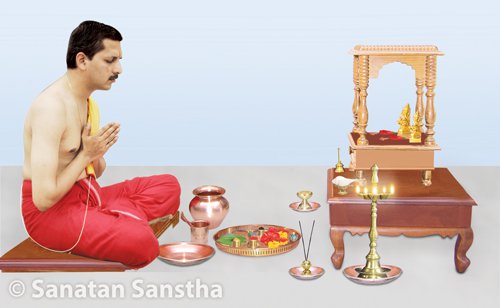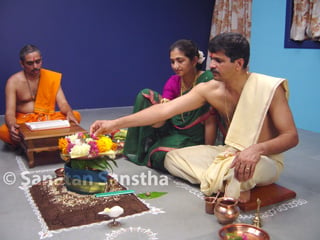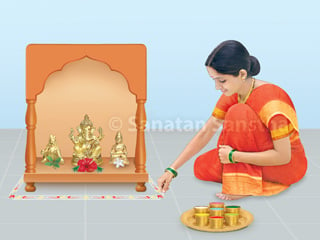The puja implements are at the forefront in attracting Pancha-tattva (Five Cosmic Principles) from the universe and appealing to the Deity Principle in the Idol. They also act as the prime source in the task of making the Deity’s Principle available to the individual. Hence, it is the prime duty of an individual which performs the puja to first awaken the divinity in them by performing their puja, addressing them with due respect and taking their help for getting the task completed with desired results. Performing the puja of these implements imparts them with divinity. This makes them sensitive to imbibe the Divine waves that are emitted at the respective stages. As a result, the sagun (Materialised) waves emanating from the Deity in the form of a flow are made available easily to the individual at the respective stages. Hence, from the perspective of getting the desired result, it is only appropriate that these implements be worshipped and prayed to at the commencement of the puja.
1. Why are the kalash, conch, bell
and lamp worshipped in this very sequence?

The shape of the kalash represents the expansiveness of the universe. The conch and bell represent the rhythmic sound in the pind arising out of the exchange of the gross waves of Chaitanya, and the flame in the form of lamp is a symbol of the Atmajyoti in the pind, which stabilises in the Chaitanya. Worshipping sequentially through the medium of kalash, conch, bell and lamp transform gradually the pervasive flow of the Deity’s nirgun (Non-materialised) Principle into sagun, that is, into the flame of the lamp that is representative of the Tej-tattva (Absolute Fire Principle). Thus, obtaining benefit from the respective waves and finally stabilising on the lamp (that is a symbol of the Atmajyoti) indicates the transition phase in the process of the individual becoming introverted.
2. What is the importance of offering
sandalwood-paste, akshata, flowers and tulsi leaf to the implements ?
Tulsi leaves are associated with activity, sandalwood-paste is associated with awakening of the nirgun Principle, flowers represent the sagun, while akshata (Unbroken rice grains smeared with saffron and used in puja) are all-encompassing. All these components lead in attracting sattvik waves of the respective Deities, which are associated with the character of the worshipper. Hence, in order to generate the respective Divine waves in the implements at the respective levels, they too are worshipped ceremoniously before the rituals in the puja.
Sandalwood-paste
Waves associated with the nirgun Principle in the sandalwood-paste largely purify the environment around the worshipper. When performed in such a suitable environment, the extent of obstacles in the puja is less.
Akshata
They bestow the worshipper with the required Principle of the Deity through different objects.
Flowers
Through the medium of the flower, a worshipper obtains gross waves emitted by the Deity and his body is purified.
Tulsi leaves
Kriya-shakti (Energy of action) associated with Deities, inherent in implements, gets awakened with tulsi leaves, and inspires the worshipper to perform the respective act in the puja.
The energy created by the coming together of sandalwood-paste, akshata and flowers is associated with the Tej-predominant gaseous form. This awakens the sound waves attracted to the void of the bell and provides momentum to their tasks. Since this energy is also associated with the acquiring of Tej-tattva, it is conducive in keeping the radiance of the lamp in a lit state for a longer period. ‘Lit’ here means keeping the flame burning or functional with the help of its inherent energy. The energy associated with the friction-oriented Tej-predominant gaseous form generated by the coming together of sandalwood-paste, akshata and flowers is helpful in awakening specific characteristics of the respective implements and initiating them to function.
3. Why should akshata not be offered to a conch ?
The conch in a puja has been given the position of the indestructible Brahman. One whose sound symbolises all-encompassing characteristics and is a consequential symbol of pervasiveness, the conch has been honoured by giving it the position of Shiva in the form of Brahman. The conch, which itself is a symbol of activity of supplication, meaning, it is in an awakened state, needs no awakening through the saguṇ all-encompassing medium of the akshata. That is why, during puja, akshata are not offered to a conch.
4. While performing puja of a conch why should it be filled with water ?
The dormant sound waves situated in the void of the conch acquire a flowing nature and obtain momentum due to the contact with the Apa-tattva (Absolute Water Principle)-predominant waves in the water. Thus, they become capable of functioning independently at the sagun level. Puja of the conch (that is filled with water) increases the emission capability of the Chaitanya-predominant marak (Destroyer) waves emitting from the conch, and this leads to purification of the premises. It helps the worshipper derive maximum benefit of the Chaitanya emitting from the puja.
5. Why is a tulsi leaf not used in puja of a bell ?
The bell itself is Shiva form; this means that it denotes association with sound and the destroyer aspect. Hence, tulsi leaves are not offered to the bell. Tulsi leaves have maximum ability to attract and concentrate the waves of respective Deities with the help of Kriya-shakti (Energy of action). As a result of this ability, grossness is imparted to the sound waves emanating from the void of the bell. The possibility itself of, concentration of the waves at the same point is high. This can hamper the emission of sound vibrations and adversely affect their ability to disintegrate the Raja-Tama in the atmosphere. To prevent this, as far as possible, tulsi leaves are not offered to the bell.
6. While performing puja of a lamp, why
is it offered haldi-kumkum along with other items ?
A lamp is Tej-predominant; it disintegrates particles of Raja-Tama present in the atmosphere. The energy emitting from the lamp travels upward and dissipates swiftly into the atmosphere. The contact with the earth waves emitting from haldi (Turmeric) imparts grossness to the Tej waves being emitted by the lamp. Consequently, the atmosphere charged with this Tej, stabilises at the floor level and can provide benefit to an average individual. Similarly, the upward-bound Tej waves emanating from the lamp get the necessary strength from the energy waves emitted through the medium of kumkum (Vermilion) to travel continuously to the upper layer of the atmosphere. This makes it possible for the individual to derive benefit from the Tej-predominant sattvikta (Purity) of the lamp for a longer period. It is, therefore, preferable that haldi-kumkum be offered at the time of puja of a lamp. Through the medium of haldi-kumkum, the Tej waves are restrained from getting swiftly dissipated into the atmosphere.

 What are the benefits obtained from Puja preparations?
What are the benefits obtained from Puja preparations? Importance of drawing Rangoli as a part of Puja preparations
Importance of drawing Rangoli as a part of Puja preparations Sounding of a conch at the commencement of a puja
Sounding of a conch at the commencement of a puja Importance of applying tilak or bhasma by the pujak while performing Puja
Importance of applying tilak or bhasma by the pujak while performing Puja Clothes to be worn by men and women while performing Puja
Clothes to be worn by men and women while performing Puja Why should we perform Puja immediately after a bath?
Why should we perform Puja immediately after a bath?